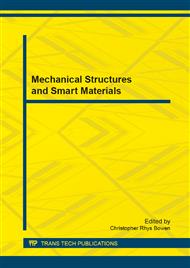[1]
K. Sung Ki, Analysis on Thermal Management Schemes of LED Backlight Units for Liquid Crystal Displays, Components, Packaging and Manufacturing Technology, IEEE Transactions on, vol. 2, pp.1838-1846, (2012).
DOI: 10.1109/tcpmt.2012.2212901
Google Scholar
[2]
C.P. Wang, T.T. Chen, H.K. Fu, T.L. Chang, P.T. Chou, and M.T. Chu, Analysis of thermal characteristics and mechanism of degradation of flip-chip high power LEDs, Microelectronics Reliability, vol. 52, pp.698-703, (2012).
DOI: 10.1016/j.microrel.2011.11.009
Google Scholar
[3]
M. Fathi, A. Aissat, and M. Abderrazak, Optimization of the Electronic Driver and Thermal Management of LEDs Lighting Powered by Solar PV, Energy Procedia, vol. 18, pp.291-299, (2012).
DOI: 10.1016/j.egypro.2012.05.040
Google Scholar
[4]
H. Fengze, Y. Daoguo, G. Q. Zhang, and L. Dongjing, Research on heat dissipation of high heat flux multi-chip GaN-based white LED lamp, in Electronic Packaging Technology and High Density Packaging (ICEPT-HDP), 2011 12th International Conference on, 2011, pp.1-5.
DOI: 10.1109/icept.2011.6067020
Google Scholar
[5]
J.C. Shyu, K.W. Hsu, K.S. Yang, and C.C. Wang, Orientation effect on heat transfer of a shrouded LED backlight panel with a plate-fin array, International Communications in Heat and Mass Transfer, vol. 42, pp.51-54, (2013).
DOI: 10.1016/j.icheatmasstransfer.2012.12.006
Google Scholar
[6]
L. Y. Bing, On Thermal Structure Optimization of a Power LED Lighting, Procedia Engineering, vol. 29, pp.2765-2769, (2012).
DOI: 10.1016/j.proeng.2012.01.387
Google Scholar
[7]
R. Vairavan, Z. Sauli, V. Retnasamy, R. C. Ismail, N. I. M. Nor, N. S. Nadzri, and H. Kamarudin, High Power LED Thermal and Stress Simulation on Copper Slug, in Computer Modelling and Simulation (UKSim), 2013 UKSim 15th International Conference on, 2013, pp.294-298.
DOI: 10.1109/uksim.2013.150
Google Scholar
[8]
V. Retnasamy, Z. Sauli, N. A. Rahman, R. M. Hatta, R. Vairavan, and W. M. W. Norhaimi, Gold Ball Shear Stress Analysis on Different Surface Morphology, in Computational Intelligence, Modelling and Simulation (CIMSiM), 2012 Fourth International Conference on, 2012, pp.168-171.
DOI: 10.1109/cimsim.2012.88
Google Scholar
[9]
M. W. Shin and S. H. Jang, Thermal analysis of high power LED packages under the alternating current operation, Solid-State Electronics, vol. 68, pp.48-50, (2012).
DOI: 10.1016/j.sse.2011.10.033
Google Scholar


